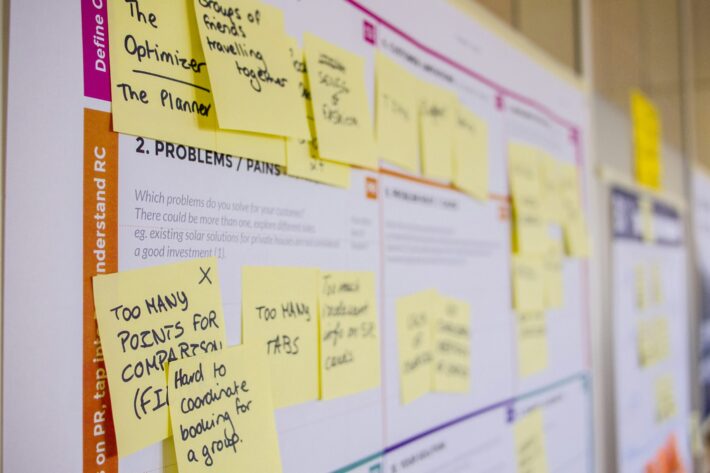What is the Engineering Design Process? A Complete Guide

[et_pb_section bb_built=”1″ _builder_version=”3.0.47″ custom_padding=”4px|0px|0|0px|false|false” next_background_color=”#000000″][et_pb_row _builder_version=”3.0.47″ background_size=”initial” background_position=”top_left” background_repeat=”repeat” custom_padding=”1px|0px|4px|0px|false|false”][et_pb_column type=”4_4″][et_pb_text _builder_version=”3.3.1″]
What is Engineering Design Process? Engineers go through a set of processes in the engineering collaborative design process in order to solve an issue. The procedures include techniques for solving problems, such as choosing your goals and limitations, prototyping, testing, and assessment.
Iterative design follows a set of planned processes, some of which may need to be repeated before going on to the next. This varies depending on the project at hand, but it enables mistakes to be learned from and advancements to be achieved.
The procedure enables the application of applied science, mathematics, and engineering disciplines to reach a high degree of optimization in order to satisfy an objective’s criteria. The procedures include techniques for solving problems, such as choosing your goals and limitations, prototyping, testing, and assessment.
Although the phases of the engineering graphic design process are not always carried out in order, it is typical for engineers to identify the issue and generate ideas before developing a prototype test that is then adjusted and enhanced until the solution satisfies the project’s requirements. Iteration is a term used to describe this approach of working.
[/et_pb_text][/et_pb_column][/et_pb_row][et_pb_row _builder_version=”3.3.1″ custom_padding=”27px|0px|3px|0px|false|false”][et_pb_column type=”4_4″][et_pb_image align=”center” force_fullwidth=”on” src=”https://www.quickreviewer.com/wp-content/uploads/2022/08/graphic-design-process.jpg” _builder_version=”3.3.1″ /][/et_pb_column][/et_pb_row][et_pb_row _builder_version=”3.3.1″ custom_padding=”3px|0px|27px|0px|false|false”][et_pb_column type=”4_4″][et_pb_text _builder_version=”3.3.1″]
Engineering Design Process Steps
1. Describe the Issue
Engineers need to define the problem that needs to be solved. Who is the design product for, and the reason it is important to find a solution. They also need to have an idea about the limitations and requirements they have. Engineers need to ask these types of critical questions regardless of what is being created.
2. Identify Potential Solutions
Before choosing to begin a design, good designers develop as long a list of potential options as they can. It is advisable to refrain from critiquing the designs and simply allow the thoughts flow.
3. Explore Possibilities
Utilize other people’s experience to investigate alternatives. You can prevent the issues encountered by others by looking at previous efforts. Speak with individuals from varied backgrounds, such as users or consumers. You could come across some solutions that you hadn’t thought about.
4. Create standards and limitations
The following stage is to identify any elements that could limit your work once you’ve identified alternative solutions and defined the project’s requirements alongside your study. This may be accomplished by going over the specifications once more and combining your discoveries and suggestions from earlier phases.
5. Consider Alternative Solutions
To assess alternative results and choose the optimal course of action, you might want to take into account additional solutions. For each workable concept, this will need repeating a few of the earlier phases.
6. Decide On A Strategy
After evaluating your available alternatives, you may choose the strategy that best satisfies your needs. Reject those that don’t adhere to your standards.
7. Create A Design Proposition
After deciding on a strategy, the following stage is to improve the proposed solution and provide a design proposal. Even after a product has been delivered to clients, this stage may continue throughout the duration of your project.
8. Create A Prototype Or Model
Create a prototype using your design proposal to test the functionality of the finished product. Prototypes are often completed to a lower grade and produced using materials other than those used in the final product.
9. Test and Evaluate
Each prototype will need to be put to the test, revised, and improved. By testing and evaluating, you may determine where impr
10. Design Refinement
The design can be altered and enhanced when testing is finished. As more prototypes are developed and tested, this procedure can be done numerous times.
11. Develop the remedy
You can select and develop your final answer once your revisions have been done and thoroughly tested. This might appear as a finished prototype that is shown to clients.
12. Communicate the Results
The last step is to present your findings. A report, presentation, display board, or combinations of approaches are all acceptable ways to deliver this. Your completed product may be made in accordance with the necessary quality requirements thanks to thorough documentation.
Final Thoughts
Engineering has the authority to use technology to address certain issues. For engineers to develop and construct practical solutions, they must be aware of the resources at their disposal and the limitations they must work within. After describing the issue, its limitations, and available resources, the brainstorming process generates a number of potential solutions.
The performance of prototypes created using the most practical method must be carefully evaluated under a variety of scenarios, ideally with end users involved. The engineering design process, which is characterized by a cycle of iterating on these processes, is how the most cutting-edge goods of today are made.
[/et_pb_text][/et_pb_column][/et_pb_row][/et_pb_section][et_pb_section bb_built=”1″ _builder_version=”3.3.1″ custom_padding=”0|0px|0|0px|false|false” prev_background_color=”#000000″ next_background_color=”rgba(193,193,193,0.29)” global_module=”4187″][et_pb_row global_parent=”4187″ background_position=”top_left” background_repeat=”repeat” background_size=”initial”][et_pb_column type=”4_4″][et_pb_social_media_follow global_parent=”4187″ _builder_version=”3.3.1″ follow_button=”on”][et_pb_social_media_follow_network _builder_version=”3.3.1″ social_network=”facebook” skype_action=”call” url=”https://www.facebook.com/quickreviewer/” background_color=”#3b5998″ use_background_color_gradient=”off” background_color_gradient_start=”#2b87da” background_color_gradient_end=”#29c4a9″ background_color_gradient_type=”linear” background_color_gradient_direction=”180deg” background_color_gradient_direction_radial=”center” background_color_gradient_start_position=”0%” background_color_gradient_end_position=”100%” background_color_gradient_overlays_image=”off” parallax=”off” parallax_method=”on” background_size=”cover” background_position=”center” background_repeat=”no-repeat” background_blend=”normal” allow_player_pause=”off” background_video_pause_outside_viewport=”on” box_shadow_style=”none”]
[/et_pb_social_media_follow_network][et_pb_social_media_follow_network _builder_version=”3.3.1″ social_network=”twitter” skype_action=”call” url=”https://twitter.com/quickreviewer” background_color=”#00aced” use_background_color_gradient=”off” background_color_gradient_start=”#2b87da” background_color_gradient_end=”#29c4a9″ background_color_gradient_type=”linear” background_color_gradient_direction=”180deg” background_color_gradient_direction_radial=”center” background_color_gradient_start_position=”0%” background_color_gradient_end_position=”100%” background_color_gradient_overlays_image=”off” parallax=”off” parallax_method=”on” background_size=”cover” background_position=”center” background_repeat=”no-repeat” background_blend=”normal” allow_player_pause=”off” background_video_pause_outside_viewport=”on” box_shadow_style=”none”]
[/et_pb_social_media_follow_network][et_pb_social_media_follow_network _builder_version=”3.3.1″ social_network=”pinterest” skype_action=”call” url=”https://www.pinterest.com/QuickReviewer/” background_color=”#cb2027″ use_background_color_gradient=”off” background_color_gradient_start=”#2b87da” background_color_gradient_end=”#29c4a9″ background_color_gradient_type=”linear” background_color_gradient_direction=”180deg” background_color_gradient_direction_radial=”center” background_color_gradient_start_position=”0%” background_color_gradient_end_position=”100%” background_color_gradient_overlays_image=”off” parallax=”off” parallax_method=”on” background_size=”cover” background_position=”center” background_repeat=”no-repeat” background_blend=”normal” allow_player_pause=”off” background_video_pause_outside_viewport=”on” box_shadow_style=”none”]
[/et_pb_social_media_follow_network][et_pb_social_media_follow_network _builder_version=”3.3.1″ social_network=”instagram” skype_action=”call” url=”https://www.instagram.com/quickreviewer/” background_color=”#ea2c59″ use_background_color_gradient=”off” background_color_gradient_start=”#2b87da” background_color_gradient_end=”#29c4a9″ background_color_gradient_type=”linear” background_color_gradient_direction=”180deg” background_color_gradient_direction_radial=”center” background_color_gradient_start_position=”0%” background_color_gradient_end_position=”100%” background_color_gradient_overlays_image=”off” parallax=”off” parallax_method=”on” background_size=”cover” background_position=”center” background_repeat=”no-repeat” background_blend=”normal” allow_player_pause=”off” background_video_pause_outside_viewport=”on” box_shadow_style=”none”]
[/et_pb_social_media_follow_network][et_pb_social_media_follow_network _builder_version=”3.3.1″ social_network=”linkedin” skype_action=”call” url=”https://www.linkedin.com/showcase/quickreviewer” background_color=”#007bb6″ use_background_color_gradient=”off” background_color_gradient_start=”#2b87da” background_color_gradient_end=”#29c4a9″ background_color_gradient_type=”linear” background_color_gradient_direction=”180deg” background_color_gradient_direction_radial=”center” background_color_gradient_start_position=”0%” background_color_gradient_end_position=”100%” background_color_gradient_overlays_image=”off” parallax=”off” parallax_method=”on” background_size=”cover” background_position=”center” background_repeat=”no-repeat” background_blend=”normal” allow_player_pause=”off” background_video_pause_outside_viewport=”on” box_shadow_style=”none”]
[/et_pb_social_media_follow_network][et_pb_social_media_follow_network _builder_version=”3.3.1″ social_network=”youtube” skype_action=”call” url=”https://www.youtube.com/@quickreviewer8129″ background_color=”#a82400″ use_background_color_gradient=”off” background_color_gradient_start=”#2b87da” background_color_gradient_end=”#29c4a9″ background_color_gradient_type=”linear” background_color_gradient_direction=”180deg” background_color_gradient_direction_radial=”center” background_color_gradient_start_position=”0%” background_color_gradient_end_position=”100%” background_color_gradient_overlays_image=”off” parallax=”off” parallax_method=”on” background_size=”cover” background_position=”center” background_repeat=”no-repeat” background_blend=”normal” allow_player_pause=”off” background_video_pause_outside_viewport=”on” box_shadow_style=”none”]
Youtube
[/et_pb_social_media_follow_network][/et_pb_social_media_follow][/et_pb_column][/et_pb_row][/et_pb_section][et_pb_section bb_built=”1″ _builder_version=”3.3.1″ background_color=”rgba(193,193,193,0.29)” custom_padding=”0|0|0|0px|false|false” saved_tabs=”all” prev_background_color=”#ffffff” disabled=”on” next_background_color=”#ffffff” global_module=”4185″][et_pb_row global_parent=”4185″ custom_padding=”40px|0|41px|0px|false|false” _builder_version=”3.3.1″][et_pb_column type=”4_4″][et_pb_text global_parent=”4185″ _builder_version=”3.3.1″ header_font=”||||||||” header_5_font=”||||||||” header_5_font_size=”30px” header_5_line_height=”1.2em”]
Break through the noise, Get clear client reviews on your projects “FAST”. Now!
[/et_pb_text][et_pb_button global_parent=”4185″ button_url=”https://www.quickreviewer.com/pricing/” url_new_window=”on” button_text=”Click here for Forever Free plan.” button_alignment=”center” _builder_version=”3.3.1″ custom_button=”on” button_text_color=”#000000″ button_bg_color=”#e09900″ button_border_width=”0px” button_font=”||||||||” box_shadow_style=”preset2″]
[/et_pb_button][/et_pb_column][/et_pb_row][/et_pb_section][et_pb_section bb_built=”1″ _builder_version=”3.3.1″ custom_padding=”0|0px|14px|0px|false|false” prev_background_color=”rgba(193,193,193,0.29)” global_module=”4188″][et_pb_row global_parent=”4188″ custom_padding=”27px|0px|0|0px|false|false” _builder_version=”3.3.1″][et_pb_column type=”4_4″][et_pb_text global_parent=”4188″ _builder_version=”3.3.1″]
Some other Posts you might be interested in.
[/et_pb_text][/et_pb_column][/et_pb_row][et_pb_row global_parent=”4188″ _builder_version=”3.3.1″][et_pb_column type=”4_4″][et_pb_blog global_parent=”4188″ fullwidth=”off” posts_number=”6″ include_categories=”1″ show_categories=”off” show_pagination=”off” _builder_version=”3.3.1″ header_level=”h4″ header_font=”||||||||” header_font_size=”16px” header_line_height=”1.3em” custom_css_main_element=”.post-content{display:none;}” /][/et_pb_column][/et_pb_row][/et_pb_section]



